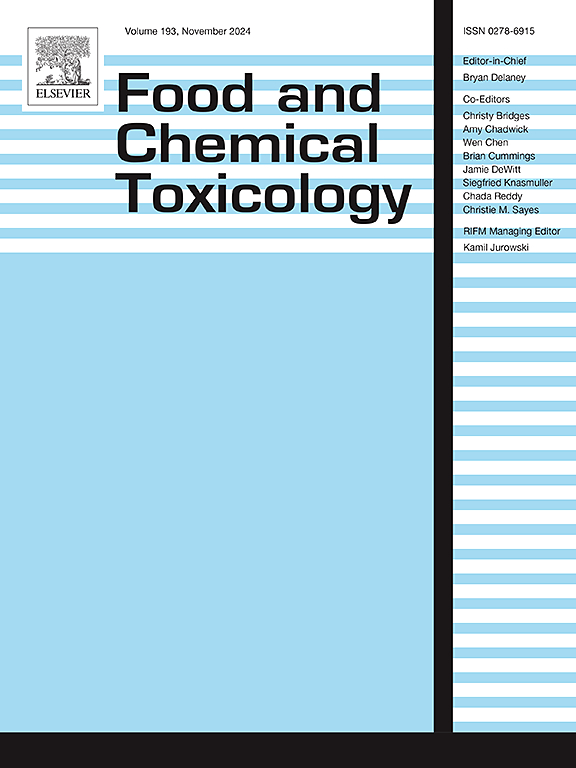Repurposing levomilnacipran to attenuate premature ovarian insufficiency induced by cyclophosphamide in female Wistar albino rats through modulation of TLR4/p38-MAPK/NF-κB p65, caspase-3-driven apoptosis, and Klotho protein expression
IF 3.9
3区 医学
Q2 FOOD SCIENCE & TECHNOLOGY
引用次数: 0
Abstract
Aim
This study aims to explore the mitigative impact of levomilnacipran (LVM) against cyclophosphamide (CPA)-induced premature ovarian insufficiency by targeting TLR4/p38 MAPK/NF-κB p65, and klotho expression.
Methods
Rats were allocated into five groups as follows: control, LVM, CPA, CPA + LVM, and CPA + TRI. Serum hormones and histopathological examination were performed. To assess oxidative stress, ovarian MDA, GSH, and SOD were evaluated. The ovarian contents of caspase-3 and inflammatory markers were assessed using the ELISA method. The expression of ovarian NF-κB p65 was examined using an immunohistochemical technique. RT-qPCR was used to measure Bax and Bcl-2 mRNA expression. Utilizing a Western blot, the TLR4, p38 MAPK, α-Klotho, and cleaved caspase-3 levels were estimated. The estrous cycle was also monitored.
Findings
LVM attenuated CPA-induced ovarian toxicity by regulating hormones and alleviating histopathological aberrations. It also raised SOD and GSH levels and lowered MDA's ovarian content. Moreover, Bcl-2 levels were raised, Bax and caspase-3 expression levels were reduced, and IL-18, IL-1β, and TNF-α levels were all reduced. LVM-induced ovarian protection by diminishing TLR4/p38 MAPK/NF-κB p65 expression and boosting the protein levels of α-Klotho.
Significance
LVM mitigated POI caused by CPA by downregulating TLR4/p38 MAPK/NF-κB p65, enhancing the α-Klotho level and attenuating caspase-3 derived apoptosis.

左旋milnacpran通过调节TLR4/p38-MAPK/NF-κB p65、caspase-3驱动细胞凋亡和Klotho蛋白表达,减轻环磷酰胺诱导的雌性Wistar白化大鼠卵巢功能不全
目的探讨左旋米那西普兰(LVM)通过调控TLR4/p38 MAPK/NF-κB p65和klotho的表达,对环磷酰胺(CPA)诱导的卵巢早衰的缓解作用。方法将大鼠分为对照组、LVM组、CPA组、CPA + LVM组和CPA + TRI组。进行血清激素及组织病理学检查。为了评估氧化应激,评估卵巢MDA、GSH和SOD。采用ELISA法检测卵巢caspase-3及炎性标志物含量。采用免疫组化技术检测卵巢NF-κB p65的表达。RT-qPCR检测Bax和Bcl-2 mRNA表达。利用Western blot方法,估计TLR4、p38 MAPK、α-Klotho和cleaved caspase-3的水平。还监测了发情周期。发现slvm通过调节激素和减轻组织病理异常来减轻cpa诱导的卵巢毒性。它还提高了SOD和GSH水平,降低了MDA的卵巢含量。Bcl-2水平升高,Bax、caspase-3表达水平降低,IL-18、IL-1β、TNF-α水平均降低。lvm通过降低TLR4/p38 MAPK/NF-κB p65表达和提高α-Klotho蛋白水平诱导卵巢保护。elvm通过下调TLR4/p38 MAPK/NF-κB p65,提高α-Klotho水平,减轻caspase-3衍生的凋亡,减轻CPA所致POI。
本文章由计算机程序翻译,如有差异,请以英文原文为准。
求助全文
约1分钟内获得全文
求助全文
来源期刊

Food and Chemical Toxicology
工程技术-毒理学
CiteScore
10.90
自引率
4.70%
发文量
651
审稿时长
31 days
期刊介绍:
Food and Chemical Toxicology (FCT), an internationally renowned journal, that publishes original research articles and reviews on toxic effects, in animals and humans, of natural or synthetic chemicals occurring in the human environment with particular emphasis on food, drugs, and chemicals, including agricultural and industrial safety, and consumer product safety. Areas such as safety evaluation of novel foods and ingredients, biotechnologically-derived products, and nanomaterials are included in the scope of the journal. FCT also encourages submission of papers on inter-relationships between nutrition and toxicology and on in vitro techniques, particularly those fostering the 3 Rs.
The principal aim of the journal is to publish high impact, scholarly work and to serve as a multidisciplinary forum for research in toxicology. Papers submitted will be judged on the basis of scientific originality and contribution to the field, quality and subject matter. Studies should address at least one of the following:
-Adverse physiological/biochemical, or pathological changes induced by specific defined substances
-New techniques for assessing potential toxicity, including molecular biology
-Mechanisms underlying toxic phenomena
-Toxicological examinations of specific chemicals or consumer products, both those showing adverse effects and those demonstrating safety, that meet current standards of scientific acceptability.
Authors must clearly and briefly identify what novel toxic effect (s) or toxic mechanism (s) of the chemical are being reported and what their significance is in the abstract. Furthermore, sufficient doses should be included in order to provide information on NOAEL/LOAEL values.
 求助内容:
求助内容: 应助结果提醒方式:
应助结果提醒方式:


